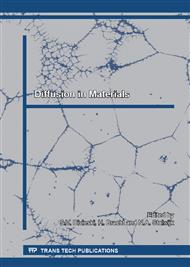[1]
K. Cooper, E. Jakobsson, P. Wolynes, The theory of ion transport through membrane channels. Prog. Biophys Molec. Biol. 46 (1985) 51-96.
DOI: 10.1016/0079-6107(85)90012-4
Google Scholar
[2]
B. Corry, S. Kuyucak, S-H. Chung, Dielectric self-energy Poisson – Boltzmann and Poisson-Nernst-Plack models of ion channels. Biophys. J. 84 (2003) 3594-3606.
DOI: 10.1016/s0006-3495(03)75091-7
Google Scholar
[3]
B. Corry, S. Kuyucak, S-H. Chung, Test of continuum theories as models of ion channels. II. Poisson-Nernst-Planck theory versus Brownian dynamics. Biophys. J. 78 (2000) 2364-2381.
DOI: 10.1016/s0006-3495(00)76781-6
Google Scholar
[4]
C. Adcock, G.R. Smith, M.S.P. Sansom, Electrostatitics and the ion selectivity of ligand-gated channels. Biophys. J. 75 (1998) 1211-1222.
DOI: 10.1016/s0006-3495(98)74040-8
Google Scholar
[5]
W. Cheng, C.X. Wang, W.Z. Chen, Y. W. Xu, Y.Y. Shi, Investigating the dielectric effects of channel pore water on the electrostatic barriers of the permeation ion by the finite difference Poisson-Boltzmann method. Eur. Biophys. J. 27 (1998).
DOI: 10.1007/s002490050116
Google Scholar
[6]
P. Jordan, R.J. Bacquet, J.A. McCammon, P. Tran, How electrolyte shielding influences the electrical potential in transmembrane ion channels, Biophys. J. 55 (1989) 1041-1052.
DOI: 10.1016/s0006-3495(89)82903-0
Google Scholar
[7]
D.G. Levitt, Strong electrolyte continuum theory solution for equilibrium profiles, diffusion limitation, and conductance in charged ion channels. Biophys. J. 48 (1985) 19-31.
DOI: 10.1016/s0006-3495(85)83757-7
Google Scholar
[8]
P. Weetman, S. Goldman, C.G. Gray, Use of Poisson-Boltzmann equation to estimate the electrostatic free energy barrier for dielectric models of biological ion channels. J. Phys. Chem. 101 (1997) 6073-6078.
DOI: 10.1021/jp971162t
Google Scholar
[9]
R.S. Eisenberg, From structure to function in open ionic channel, J. Membr. Biol. 171 (1999) 1-24.
Google Scholar
[10]
M.G. Kurnikova, R.D. Coalson, P. Graf, A. Nitzan, A lattice relaxation algorithm for three-dimensional Poisson-nernst-Planck theory with application to ion transport through the Gramicidin A channel, Biophys. J. 76 (1999) 642-656.
DOI: 10.1016/s0006-3495(99)77232-2
Google Scholar
[11]
W. Nonner, L. Catacuzzeno, B. Eisenberg, Binding and selectivity in L-type calcium channels: a mean spherical approximation. Biophys. J. 79 (2000) 1976-(1992).
DOI: 10.1016/s0006-3495(00)76446-0
Google Scholar
[12]
Valent, P. Petrovic, P. Neogrady, I. Schreiber, M. Marek, Electrodiffusion kinetics of ionic transport in a simple membrane channel, J. Phys. Chem. 117 (2013) 14283-14293.
DOI: 10.1021/jp407492q
Google Scholar
[13]
B. Roux, T. Allen, S. Berneche, W. Im, Theoretical and computational models of biological ion channels, Q. Rev. Biophys. 37 (2004) 15-103.
DOI: 10.1017/s0033583504003968
Google Scholar
[14]
B. Roux, The membrane potential and its representation by a constant electric field in computer simulations, Biophys. J. 95 (2008) 4205-4216.
DOI: 10.1529/biophysj.108.136499
Google Scholar
[15]
C. Kutzner, H. Grubmuller, B.L. de Groot, U. Zachariae, Computational electrophysiology: The molecular dynamics of ion channel permeation and selectivity in atomistic detail, Biphys. J. 101 (2011) 809-817.
DOI: 10.1016/j.bpj.2011.06.010
Google Scholar
[16]
M. Jensen, W. Borhani, K. Lindorff-Larsen, P. Maragakis, V. Jogini, M. P. Eastwood, R. O. Dror, D.E. Shaw, Principles of conduction and hydrophobic gating in K+ channels, Proc. Natl. Acad. Sci. USA 107 (2010) 5833-5838.
DOI: 10.1073/pnas.0911691107
Google Scholar
[17]
D. P. Tieleman, H. Leontiadou, A.E. Mark, S.J. Marrink, Simulation of pore formation in lipid bilayers by mechanical stress and electric fields, J. Am. Chem. Soc. 125 (2003) 6382-6383.
DOI: 10.1021/ja029504i
Google Scholar
[18]
V. Barcilon, D.P. Chen, R.S. Eisenberg, Ion flow through narrow membrane channels, J. Appl. Math. 52 (1992) 1405-1425.
DOI: 10.1137/0152081
Google Scholar
[19]
D.P. Chen, V. Barcilon, R.S. Eisenberg, Constant fields and constant gradients in open ionic channels, Biophys. J. 61 (1992) 1372-1393.
DOI: 10.1016/s0006-3495(92)81944-6
Google Scholar
[20]
D. P. Chen, R. S. Eisenberg, Charges, currents and potentials in ionic channels of one confor-mation, Biophys. J. 64 (1993) 1405-1421.
DOI: 10.1016/s0006-3495(93)81507-8
Google Scholar
[21]
D.P. Chen, J. Lear, R.S. Eisenberg, Permeation through an open channel: Poisson-Nernst-Planck theory of a synthetic channel, Biophys. J. 72 (1997) 97-116.
DOI: 10.1016/s0006-3495(97)78650-8
Google Scholar
[22]
D. A. Morton-Blake, Molecular Dynamics of the Transport of Ions in a Synthetic Channel, Diff. Found., 1, 77 (2014).
Google Scholar


